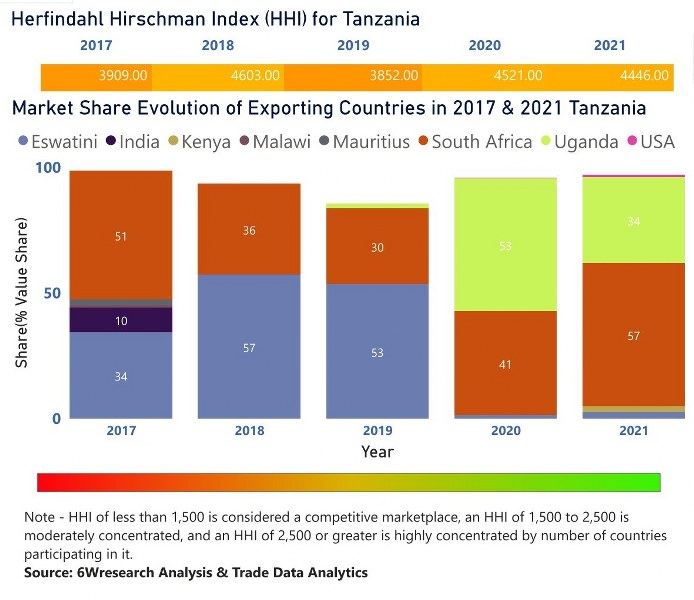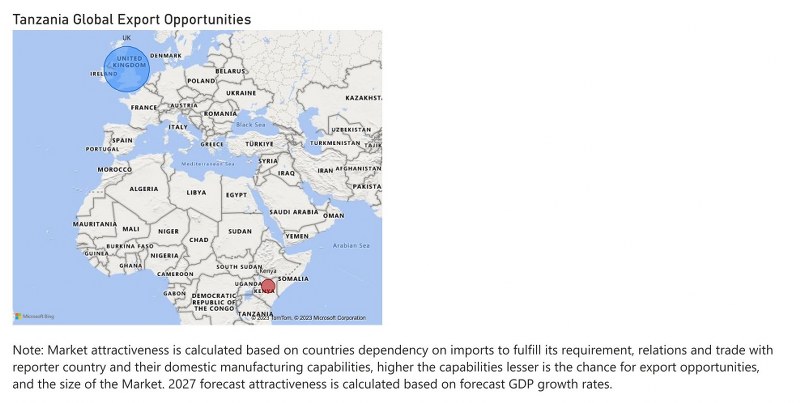Tanzania Ethanol Market (2025-2031) | Analysis, Size, Outlook, Trends, Value, Share, Industry, Growth, Companies, Revenue & Forecast
Market Forecast By Purity (Denatured, Non-Denatured), By Sources (Sugar & Molasses Based, Grained Based, Second Generation) By Application (Industrial Solvent, Fuel & Fuel Additives, Beverages, Disinfectant, Personal Care, Others) And Competitive Landscape
| Product Code: ETC003159 | Publication Date: Jul 2020 | Updated Date: Apr 2025 | Product Type: Report | |
| Publisher: 6Wresearch | No. of Pages: 70 | No. of Figures: 35 | No. of Tables: 5 | |
Tanzania Ethanol Market | Country-Wise Share and Competition Analysis
In the year 2021, South Africa was the largest exporter in terms of value, followed by Uganda. It has registered a growth of 27.82% over the previous year. While Uganda registered a decline of -40.45% as compare to the previous year. In the year 2017 South Africa was the largest exporter followed by Eswatini. In term of Herfindahl Index, which measures the competitiveness of countries exporting, Tanzania has the Herfindahl index of 3909 in 2017 which signifies high concentration also in 2021 it registered a Herfindahl index of 4446 which signifies high concentration in the market.

Tanzania Ethanol Market - Export Market Opportunities

Topics Covered in the Tanzania Ethanol Market Report
The Tanzania Ethanol Market report thoroughly covers the market by Purity, Source, and Application. The market report provides an unbiased and detailed analysis of the ongoing market trends, opportunities/high growth areas, and market drivers which would help the stakeholders to devise and align their market strategies according to the current and future market dynamics.
Tanzania Ethanol Market Synopsis
The Tanzania Ethanol Market has witnessed growth in the past years. The market is expected to continue its growth steadily in the coming years. This is due to the increasing concern about climate change, government support through investments and incentives, availability of raw materials, and urbanization.
According to 6Wresearch, the Tanzania Ethanol Market size is expected to grow at a significant CAGR of 4% during 2025-2031. One of the key drivers of the market is government support through policies and regulations. The government has implemented various initiatives and incentives to promote the production and consumption of ethanol. Another major driver is increasing environmental concerns. There has been a shift towards cleaner and sustainable energy sources including ethanol. Furthermore, the availability of raw materials is also a significant driver of the ethanol market in Tanzania. The country has an abundant supply of sugarcane, which is the primary feedstock used in ethanol production.
One of the main challenges is inadequate infrastructure for distribution and storage. Another challenge is the high initial investment required for ethanol production. Furthermore, there is a lack of awareness and education about the benefits of using ethanol as a fuel source among consumers.
Tanzania Ethanol Industry: Leading Players
Key players in the Tanzania Ethanol Market include Tanzania Distilleries Limited, Konyagi Limited, Serengeti Breweries Limited, East African Breweries Limited (EABL), TIPER - Tanzania Industrial Products, Engineering and Research Company Limited, and Manyara Sugar Company Limited. These are some of the major players in Tanzania's ethanol market, with each company having a significant presence in the production, distribution, and marketing of ethanol within the country.
Tanzania Ethanol Market: Government Regulations
One key initiative is the National Biofuels Policy, which sets out a framework for promoting biofuels, including ethanol, as a sustainable energy source. Furthermore, the government has implemented various tax incentives to encourage both producers and consumers of ethanol. Additionally, the government has also invested in infrastructure development to support the growth of the ethanol market. Moreover, the government has collaborated with private companies and international organizations to further boost the market.
Future Insights of the Market
The Tanzania ethanol market is expected to experience steady growth in the coming years due to various factors such as increasing demand from industries like pharmaceuticals, cosmetics, and food processing. The rising awareness about the benefits of using ethanol, such as its lower carbon footprint and potential for cost savings, is also expected to drive market growth. Furthermore, the government's initiatives towards promoting the use of ethanol as a sustainable source of energy will likely contribute to market expansion.
Market Segmentation by Purity
According to Ravi Bhandari, Research Head, 6Wresearch, the non-denatured segment is expected to grow significantly in the coming years due to the increasing demand for high-purity ethanol in various industries such as personal care, beverages, and industrial solvents.
Market Segmentation by Source
In terms of source, sugar & molasses-based ethanol is dominating the market due to its wide availability and low cost.
Key Attractiveness of the Report
- 10 Years of Market Numbers.
- Data Starting from 2021 to 2024.
- Base Year: 2024
- Forecast Data until 2031.
- Key Performance Indicators Impacting the Market.
- Major Upcoming Developments and Projects.
Key Highlights of the Report:
- Tanzania Ethanol Market Overview
- Tanzania Ethanol Market Outlook
- Tanzania Ethanol Market Forecast
- Historical Data of Tanzania Ethanol Market Revenues and Volumes, for the Period 2021-2031
- Market Size & Forecast of Tanzania Ethanol Market Revenues and Volumes, until 2031
- Historical Data of Tanzania Ethanol Market Revenues and Volumes, by purity, for the Period 2021-2031
- Market Size & Forecast of Tanzania Ethanol Market Revenues and Volumes, by purity, until 2031
- Historical Data of Tanzania Ethanol Market Revenues and Volumes, by Source, for the Period 2021-2031
- Market Size & Forecast of Tanzania Ethanol Market Revenues and Volumes, by source, until 2031
- Historical Data of Tanzania Ethanol Market Revenues and Volumes, by application, for the Period 2021-2031
- Market Size & Forecast of Tanzania Ethanol Market Revenues and Volumes, by application, until 2031
- Market Drivers and Restraints
- Tanzania Ethanol Market Price Trends
- Tanzania Ethanol Market Trends and Industry Life Cycle
- Porter’s Five Force Analysis
- Market Opportunity Assessment
- Tanzania Ethanol Market Share, By Players
- Tanzania Ethanol Market Overview on Competitive Benchmarking
- Company Profiles
- Key Strategic Recommendations
Markets Covered
The report provides a detailed analysis of the following market segments:
By Purity
- Denatured
- Non-Denatured
By Source
- Sugar & molasses Based
- Second Generation
- Grain Based
By Application
- Fuel & Fuel Additives
- Disinfectant
- Industrial Solvents
- Personal Care
- Beverages
- Others
Tanzania Ethanol Market (2025-2031): FAQ
| 1. Executive Summary |
| 2. Introduction |
| 2.1 Report Description |
| 2.2 Key Highlights |
| 2.3 Market Scope & Segmentation |
| 2.4 Research Methodology |
| 2.5 Assumptions |
| 3. Tanzania Ethanol Market Overview |
| 3.1 Tanzania Ethanol Market Revenues and Volume, 2021-2031F |
| 3.2 Tanzania Ethanol Market Revenue Share, By Purity, 2021&2031F |
| 3.3 Tanzania Ethanol Market Revenue Share, By Source, 2021&2031F |
| 3.4 Tanzania Ethanol Market Revenue Share, By Application, 2021&2031F |
| 3.5 Tanzania Ethanol Market - Industry Life Cycle |
| 3.6 Tanzania Ethanol Market - Porter’s Five Forces |
| 4. Tanzania Ethanol Market Dynamics |
| 4.1 Impact Analysis |
| 4.2 Market Drivers |
| 4.3 Market Restraints |
| 5. Tanzania Ethanol Market Trends |
| 6. Tanzania Ethanol Market Overview, by Source |
| 6.1 Tanzania Sugar & Molasses Based Ethanol Market Revenues and Volume, 2021-2031F |
| 6.2 Tanzania Grained Based Ethanol Market Revenues and Volume, 2021-2031F |
| 6.3 Tanzania Second Generation Ethanol Market Revenues and Volume, 2021-2031F |
| 7. Tanzania Ethanol Market Overview, by Purity |
| 7.1 Tanzania Ethanol Market Revenue and Volumes, By Denatured, 2021-2031F |
| 7.2 Tanzania Ethanol Market Revenue and Volumes, By Non-Denatured, 2021-2031F |
| 8. Tanzania Ethanol Market Overview, by Application |
| 8.1 Tanzania Ethanol Market Revenue and Volumes, By Industrial Solvent, 2021-2031F |
| 8.2 Tanzania Ethanol Market Revenue and Volumes, By Fuel & Fuel Additives, 2021-2031F |
| 8.3 Tanzania Ethanol Market Revenue and Volumes, By Beverages, 2021-2031F |
| 8.4 Tanzania Ethanol Market Revenue and Volumes, By Disinfectant, 2021-2031F |
| 8.5 Tanzania Ethanol Market Revenue and Volumes, By Personal Care, 2021-2031F |
| 8.6 Tanzania Ethanol Market Revenue and Volumes, By Others, 2021-2031F |
| 9. Tanzania Ethanol Market Key Performance Indicators |
| 10. Tanzania Ethanol Market Opportunity Assessment |
| 10.1 Tanzania Ethanol Market Opportunity Assessment, By Purity, 2031F |
| 10.2 Tanzania Ethanol Market Opportunity Assessment, By Source, 2031F |
| 10.3 Tanzania Ethanol Market Opportunity Assessment, By Application, 2031F |
| 11. Tanzania Ethanol Market Competitive Landscape |
| 11.1 Tanzania Ethanol Market By Companies, 2024 |
| 11.2 Tanzania Ethanol Market Competitive Benchmarking, By Operating Parameters |
| 12. Company Profiles |
| 13. Key Strategic Recommendations |
| 14. Disclaimer |
- Single User License$ 1,995
- Department License$ 2,400
- Site License$ 3,120
- Global License$ 3,795
Search
Related Reports
- Middle East OLED Market (2025-2031) | Outlook, Forecast, Revenue, Growth, Companies, Analysis, Industry, Share, Trends, Value & Size
- Taiwan Electric Truck Market (2025-2031) | Outlook, Industry, Revenue, Size, Forecast, Growth, Analysis, Share, Companies, Value & Trends
- South Korea Electric Bus Market (2025-2031) | Outlook, Industry, Companies, Analysis, Size, Revenue, Value, Forecast, Trends, Growth & Share
- Vietnam Electric Vehicle Charging Infrastructure Market (2025-2031) | Outlook, Analysis, Forecast, Trends, Growth, Share, Industry, Companies, Size, Value & Revenue
- Vietnam Meat Market (2025-2031) | Companies, Industry, Forecast, Value, Trends, Analysis, Share, Growth, Revenue, Size & Outlook
- Vietnam Spices Market (2025-2031) | Companies, Revenue, Share, Value, Growth, Trends, Industry, Forecast, Outlook, Size & Analysis
- Iran Portable Fire Extinguisher Market (2025-2031) | Value, Forecast, Companies, Industry, Analysis, Trends, Growth, Revenue, Size & Share
- Philippines Animal Feed Market (2025-2031) | Companies, industry, Size, Share, Revenue, Analysis, Forecast, Growth, Outlook
- India Lingerie Market (2025-2031) | Companies, Growth, Forecast, Outlook, Size, Value, Revenue, Share, Trends, Analysis & Industry
- India Smoke Detector Market (2025-2031) | Trends, Share, Analysis, Revenue, Companies, Industry, Forecast, Size, Growth & Value
Industry Events and Analyst Meet
Our Clients
Whitepaper
- Middle East & Africa Commercial Security Market Click here to view more.
- Middle East & Africa Fire Safety Systems & Equipment Market Click here to view more.
- GCC Drone Market Click here to view more.
- Middle East Lighting Fixture Market Click here to view more.
- GCC Physical & Perimeter Security Market Click here to view more.
6WResearch In News
- Doha a strategic location for EV manufacturing hub: IPA Qatar
- Demand for luxury TVs surging in the GCC, says Samsung
- Empowering Growth: The Thriving Journey of Bangladesh’s Cable Industry
- Demand for luxury TVs surging in the GCC, says Samsung
- Video call with a traditional healer? Once unthinkable, it’s now common in South Africa
- Intelligent Buildings To Smooth GCC’s Path To Net Zero













